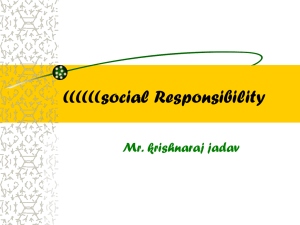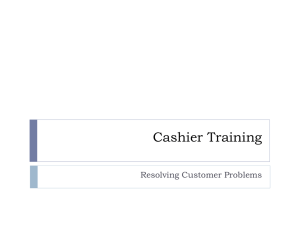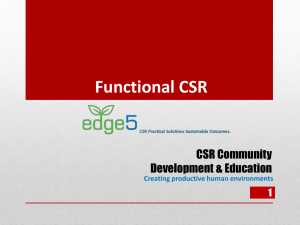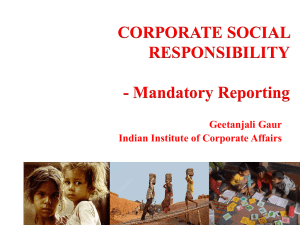The Strategic importance of CSR implementation
advertisement
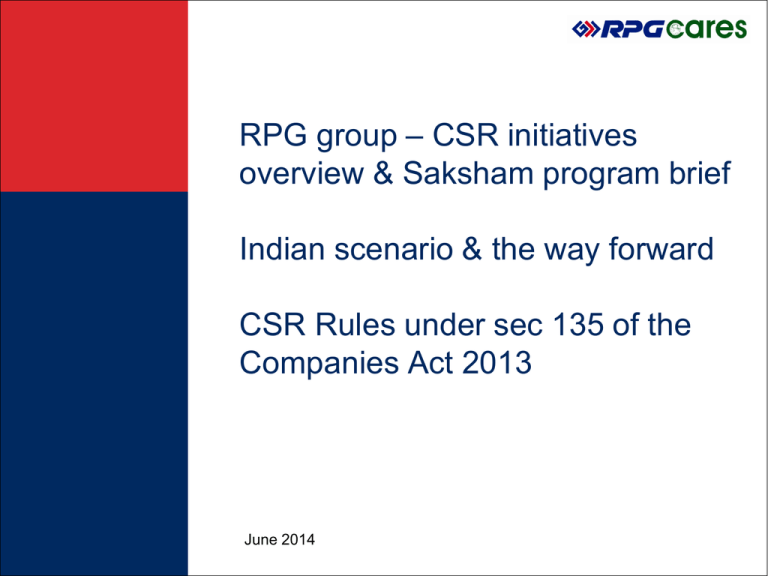
RPG group – CSR initiatives overview & Saksham program brief Indian scenario & the way forward CSR Rules under sec 135 of the Companies Act 2013 June 2014 Vision & Mission Vision To be recognised as the most favoured Indian employer who is responsible and ethical, contributing positively to the world we live in RPG Foundation ▪ Engaging with and Goals contributing to our communities around – Educate & Empower ▪ School/community Initiatives development program around all our 20 plants & offices ▪ Set-up company-wide volunteering programs Approach ▪ Being an eco-efficient company that believes in sustainable growth and makes it a part of its DNA ▪ Actively participate in the nation’s effort to bridge the huge shortfall of skilled (technical) manpower ▪ All plants to work towards ▪ Adopt Govt. ITIs to deliver Zero-Nett consumption of natural resources ▪ Establish sustainability communications and reporting on performance (internal & external) ▪ Identify and engage with ▪ Sensitise and motivate all underprivileged schools/communities for English and Life skill programmes employees to go Green and incorporate it into the Group strategy relevant and quality courses ▪ Initiate technical Education at Govt schools ▪ Revamp the adopted ITIs to be Industry-oriented. Change the mindset of Govt school students to realise the potential of Tech Education 1 | CSR Programs & Strategy Key initiatives taken ▪ Akshar program -English taught at Govt Schools Class 4 onwards. ▪ Saksham I – Adoption of Govt Technical Schools for improvement with special emphasis on technical subjects Class 9 & 10 ▪ ▪ ▪ Sakham II & III – Post SSC Continue Class 11 & 12. Followed with a one-year apprenticeship at our factories. ITI adoption – Under govt PPP Scheme – we signed with three ITI s Swayam – Train women for a career in driving. Go Green -Water-20%,Power-20% reduction, Zero discharge **KPMG 2011 Survey 2 | **Only 16% of India’s Top 100 listed companies (by Rev) have a Corpt Responsibility Strategy in place RPG CSR Highlights under 4 areas: May ‘14 1. EMPLOYABILITY : •Saksham – a six year program Class 8 to 12 + I year apprenticeship: •2012-13 (Pilot) – 4 Schools/centre (757 students). 2013-14 – 15 Schools/centres (6869) • Launched Saksham in Govt Technical Schools in 8 cities of Maharashtra & Gujarat •Improved upon the 30 key initiatives on– Infra, curriculum, methods, teachers/students. •RPG Fdtn empanelled in State Technical Syllabus Comm to revise the 20 yr old syllabus. •Shri SRamadorai (TCS), Chairman NSDA, wants Tatas to adopt the Saksham program b) ITI adoption program: •Three ITI s under our CSR initiatives for improvement under the Govt PPP Scheme . •Student dev program, infra dev, Tech staff visit to industry, MIS in place. •Leadership workshop for 25 Principals and officials of Govt schools & ITI s. c) Ceat Swayam women drivers initiative launched in Mumbai in Oct 2013. •Identified all stakeholders across Govt, Corporates, NGOs, taxi operators, trainers etc. •1350 women addressed. 1st batch of 20 started the 3 months training in March’14. •2nd batch of 18 women launched in Bhandup at CEAT Community centre. •3rd batch due in June’14 in partnership with MERU Cabs outfit META driving school. >>>> Women need to 1st deal with “resistance within” before they get started….. | CSR Highlight : May ’14 (contd) 2. EDUCATION: Akshar program (In 9 cities, 71 schools, with 8520 students) • Proficiency in English program at Govt School from class 4 to 9. Empowering them. •Incorporated School English syllabus into Akshar content. •Two Sessions per class/week. Our own teachers visit Schools with projector/laptop 3. ENVIRONMENT : •LED lamps installed RPG House, will install shortly at Plants as replacement. •RPG House: Rain water Harvesting in place & STP commissioned in March 14. •Dry Waste Management at HO launched in Feb 13, now a sustainable program. •All 12 plants under environment monitoring chart – working towards 20% reduction in consumption of natural resources in the next 3 years. 4. Community Development at Plant locations: •Nine plants have launched community development programs on various fronts – health, education, and livelihood, soft/life skills to youth, women and adolescents. •Tied-up with USAID for Health awareness program films/content on Mother& Child. Note: Majority of the CSR initiatives at RPG were only started in early 2012 | Saksham Program Technical Education at Schools & beyond Three Stages: (A journey of Six Years) (3 + 2 + 1 = 6 years) Saksham I – At Govt Tech Schools - Maharashtra Classes 8, 9, 10 (SSC + Tech subs). Pilot Yr 2012-13 Class 7 students from Municipal Schools enrolled Saksham II – Plus 2 (MCVC or Bi-Focal). Class 11,12 also called as HSC(voc). Saksham III –(Apprenticeship at RPG. Plants)- for one year. Only one of its kind across 5 cities. In 9 Govt tech schools of Maharashtra and 2 schools in Gujarat. Engaged with 5880 students Yr 2015 8000 students 15 Schools 3 States 8 Cities 15 Tech Centres | SAKSHAM – Its three Areas of Focus at Schools • Increase the Admission Intake — (Note: two of these schools had no students to start with) Admissions School Bharo Retention School me Raho Success Gyan aur Hunar Badavo • Improve the brand equity of- ‘Govt Tech Schools’ • Engage in co / extra curricular activities • Reduce the no. of ‘Drop outs’ • Achieve students’ all-round development • Enable good scores, skills and attitude for gainful employment | 6 Series of engagements & students support system in place Employee Engagement Scalability Sustainable Advocacy Psycholo gist Partnering Capacity Building Students Student Teacher Visit: http://www.rpggroup.com/corporate_citizenship/overview/overview.aspx Social Worker | 7 SVarious initiatives under the program- “Saksham” SL NO 1 2 3 ACTIVITIES Admission into Class 8 moved up by four times, in 2012-13 to 13-14 . (Note: These two schools had zero admissions the previous two years of starting Saksham. Seventeen BMC Upper primary Schools (Up to Class 7) visited in Feb-June to seek admissions into Class 8 of GTHS ( Govt Tech High Schools) Two NGOs & four Social workers engaged for these efforts on admission drive. 4 Six Parents/community meeting conducted to garner admissions 5 Aptitude mapping conducted for Class 8 & 9th students – post admissions Counseling sessions conducted & students profile documented with recommendations from the Psychologist. 6 8 100% attendance awards distributed monthly to students -- to make regular attendance a habit 9 “Quarterly Merit Awards” given- emphasis is on student’s all round improvement quarter on quarter 10 Soft skill training to all students (1050) of these four govt tech schools 11 49 Staff members- offered subject refresher courses & also trained in soft skills. 12 Additional English communication classes for students 13 14 Result analysis of all unit test & mid term done. Parent and teacher counseling done periodically. Root cause analysis done for poor results using applied QC tools. Action plan drawn for correction. 15 Mentoring of students by 22 MBA interns - duration 40 hr over 3 mths. Recorded high benefit. | 8 continued......initiatives under Saksham S 16 eClasses introduced - resulted in improved attendance and learning both for students & teachers 17 Organised teachers & students visits to other Tech Institutes like NTTF Morbad, Industry etc. 18 Hobby classes - Art Therapy session, sports for development - to deal with youth aggression. 19 Medical check up camp: General, Eye, Dental camps & Midday Meal to improve their health 20 Books purchased for Library and implemented its usage under reward scheme for Librarian. 21 Remedial classes for weaker students regularly conducted by Pratham team 22 Staff vacancies, govt red tape etc dealt with through high level of advocacy/perseverance. 23 Infra related activities resolved and established basic facilities in place 24 Brand building activities initiated - to give a sense of pride to the students/parents about the School. Connected with private / aided technical schools to enable sharing of best practices. 25 26 Employee intervention/volunteerism - to help in student retention thru mentorship. 27 Industry partnerships for special training of staff & students with: Godrej, L&T, NTTF, Schneider Elec. 28 Implemented monthly review meetings with principals, HO officials, chaired by the Director Tech Edn. 29 Got inducted into the State committee for vocationalisation of high schools in Maharashtra 30 Conducted a 2 day workshop for school staff/principals -created a VISION & MISSION document. A 360 degree engagement for a holistic development of these schools…a unique program indeed | 9 S SSC Board offers technical subjects also * V2 (Elements of Mechanical Technology) V3(Elements of Electrical and Electronic Technology) Engineering Drawing Engineering Drawing Computer Technology Computer Technology Basic Electricity Basic Electricity Fitting and Rural Technology Fitting and Rural Technology Welding Welding Plumbing Electrical Machine & Domestic Appliances Elements of Electronics Carpentry Auto Engineering *This syllabus (optional under SSC) is being revised now after 10+ years to industry needs | 10 | 11 Why SAKSHAM? Potential for large scale skilling Opportunity to be the “Skill Capital of the World”; or A recipe for Disaster !!! New Job Creation between 2012 and 2022 (million people) Total Employment (million people) 90.0 103.3 80.0 Manufacturing & Construction 103.3 million Automobile 43.2 million IT/ ITeS 10.7 million 69.0 70.0 60.0 48.4 50.0 43.2 39.0 40.0 33.6 30.0 20.0 10.0 10.7 6.8 3.5 0.0 2012 2018 2022 *Source: Shri Ramadorai’s NSDC presentation Government of India Confidential, April 2011 156.1 million* Source : NSDC | 6 Employability scenario- advantage India RAMADORAI of NSDC on Skill status in the World v/s India:Scenario: In 2020, the average age of Indian will be only 29 years old, compared with 37 in China/US, 45 in West Europe and 48 in Japan, making India one of the young nations in the world. The age advantage, as per World Bank, will continue for at least 3 decades till 2040. We would probably never get a chance like this to leverage our human resources to help grow our country economically. Reality: Huge task to fill GTHS seats. Godrej struggles to fill their–Welding sessions. Today, we are operating at half our capacity and half our productivity levels. Of India’s 1.2 billion people, 60 per cent is in the working age group. However, only 5 percent of India’s labor force in the age group19-24 years is estimated to have acquired any formal training. Yet, our economy had until recently clocked an impressive growth. Imagine what is possible if we could leverage our demographic dividend fully! Quite clearly, India’s potential is yet to be fully exploited. | Companies Act 2013 – CSR Rules CSR Rules under sec 135 of the Companies Act 2013 | 14 Section 135-Companies Act Salient Features • • • • • CSR contribution will be 2% of average net profit before tax for last three financial years A 3 member CSR committee be appointed including one independent director. Mandatory reporting on CSR. Develop CSR policy indicating activities as per Schedule VII Preference to be given to the local areas nearby which it operates CSR Committee shall consist 3 or more directors with at least one director as an independent director CSR Expenditure • CSR Expenditure shall include all activities approved by board and recommended by CSR excluding activities not in line with Schedule VII of the act • Expenditure related to CSR capacity building of own personal and implementing agencies shall not exceed 5% of the total CSR expenditure Mode of Implementation • CSR activities can be implemented through a registered trust or a registered society or a company established by the company or its holding or subsidiary or associate company under section 8 of the act provided company must specify the projects, the modalities of fund utilization and monitoring & reporting mechanisms o In case not established by any of the three above, it shall have an established track record of 3 years in undertaking similar projects • A company can collaborate with other companies for undertaking CSR projects or programmes but respective companies should be in a position to report separately in accordance with the rules Boards' Report for a financial year commencing on or after April 1st , 2014 must include annual report on CSR containing particulars specified in annexure . This CSR report should include • Reasons for not spending 2 % of average net profit | 15 Schedule VII • Eradicating hunger, poverty and malnutrition, promoting preventive heath care and sanitation and making available safe drinking water. • Promoting education, including special education and employment enhancing vocation skills especially among children, women, elderly and the differently-abled and livelihood enhancement projects. • Promoting gender equality, empowering women, setting up homes and hostels for women and orphans, setting up old age homes, day care centres and such other facilities for senior citizens and measures for reducing inequalities faced by socially and economically backward groups. • Ensuring environmental sustainability, ecological balance, protection of flora and fauna, animal welfare, agro forestry, conservation of natural resources and maintaining quality of soil, air and water. • Protection of national heritage, art and culture including restoration of buildings and sites of historical importance and works of art; setting up public libraries; promotion and development of traditional arts and handicrafts. • Measures for the benefit of armed forces veterans, war widows and their dependents. • Training to promote rural sports, nationally recognised sports, paralympic sports and Olympic sports. • Contribution to the Prime Minister’s National Relief Fund or any other fund set up by the central government for socio-economic development and relief and welfare of the scheduled castes, the scheduled tribes, other backward classes, minorities and women. • Contribution to technology incubators within academic institutes. • Rural development projects. Items underlined indicate areas where NLS operates its CSR to an extent | 16 THANK YOU | 17


